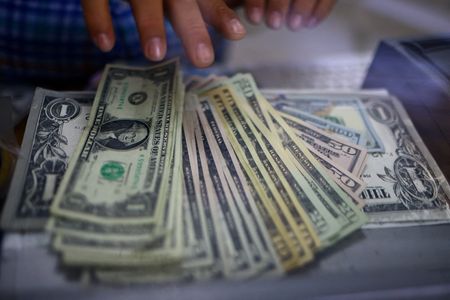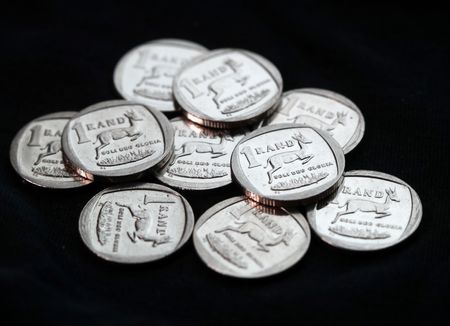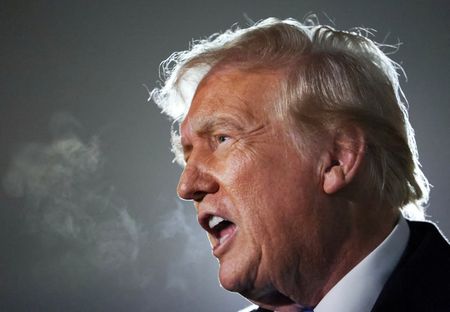By Hannah Lang
NEW YORK (Reuters) -The dollar index was lower on Monday after U.S. President Donald Trump paused new tariffs on Mexico for one month, after the country agreed to reinforce its northern border with 10,000 National Guard members to stem the flow of illegal drugs, Trump said.
Mexico and the U.S. will use the month-long suspension to engage in further negotiations, Trump said.
The delay boosted the Mexican peso. It was last up 1.25% against the dollar at 20.4196. Earlier, it fell to its lowest in nearly three years at 21.2882 per U.S. dollar.
Meanwhile, the dollar index was down 0.5% at 108.96. It had touched a three-week high of 109.88 in early trading.
“This delay to Mexico plays into this idea that the tariffs are just a transactional tool,” said Marc Chandler, chief market strategist at Bannockburn Global Forex.
As Trump promised last month, the U.S. over the weekend announced it would hit Canada and Mexico with 25% duties and China with a 10% levy starting on Tuesday, calling them necessary to curb immigration and narcotics trafficking.
Trump said on Monday he had spoken with Canadian Prime Minister Justin Trudeau and would do so again at 3 p.m. ET (2000 GMT). The tariffs on Canada and China remain poised to take effect on Tuesday, and Canada has announced retaliatory tariffs.
A senior Canadian official told a New York Times reporter that Ottawa is not optimistic that a similar reprieve is in the offing, the reporter said on X.
The Canadian dollar rose to 1.4568 per U.S. dollar, after earlier falling to a level not seen since 2003.
China said it would challenge Trump’s levies at the World Trade Organization.
The U.S. dollar was at 7.3254 yuan in the offshore market, having earlier pushed to a record high of 7.3765 yuan. Markets in China remain closed for the Lunar New Year and will resume trading on Wednesday.
The tariffs are widely expected to push up U.S. inflation, supporting the dollar by keeping U.S. interest rates higher for longer. Economists say the Republican president’s plan would also slow global growth and drive prices higher for Americans.
“What it seems like the U.S. is trying to do is build its hegemonic power back and then force the rest of the world to pay for U.S. public goods, which is typically not how government works,” said Mark McCormick, head of foreign exchange and emerging market strategy at TD Securities.
Markets pared expectations of rate cuts from the Federal Reserve in the wake of the tariff news, with futures pricing in just a 50% chance of two cuts this year.
Canada’s and Mexico’s economies are at risk of recession once the tariffs are in place, some analysts say, while the euro zone economy faces further stagnation if tariffs kick in.
Trump said over the weekend that tariffs on the European Union would go ahead, but did not say when.
EU leaders at an informal summit in Brussels on Monday said Europe would be prepared to fight back if the U.S. imposes tariffs, but also called for reason and negotiation.
The euro plunged as much as 2.3% to $1.0125 – the lowest since November 2022 – as investors braced for tariffs on Europe from the Trump administration. The single currency was last down 0.73% against the dollar at $1.0286.
The Australian dollar hit a five-year low on Monday, while the New Zealand dollar fell to its lowest since October 2022. The two Antipodean currencies are often used as liquid proxies for the Chinese yuan. [AUD/]
Japan’s yen, conversely, was resilient, with the dollar sliding 0.24% against the yen to 154.845.
Bitcoin rose back above the $100,000 level after earlier in the day hitting its weakest in nearly three weeks.
(Reporting by Hannah Lang in New York, Kevin Buckland in Tokyo, Ankur Banerjee in Singapore and Greta Rosen Fondahn in Gdansk; Editing by Rod Nickel, Nia Williams and Nick Zieminski)










